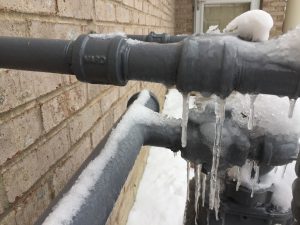Preventing Frozen Pipes in Cold Weather: Essential Strategies
Preventing Frozen Pipes in Cold Weather: Essential Strategies
Blog Article
They are making a few good points regarding How To Avoid Freezing Pipes as a whole in this great article directly below.

Cold weather can ruin your plumbing, especially by freezing pipes. Here's exactly how to stop it from taking place and what to do if it does.
Introduction
As temperature levels decline, the danger of frozen pipelines rises, potentially bring about costly repair work and water damages. Recognizing how to prevent frozen pipes is crucial for property owners in cool environments.
Avoidance Tips
Shielding susceptible pipes
Cover pipes in insulation sleeves or make use of heat tape to protect them from freezing temperatures. Focus on pipelines in unheated or exterior locations of the home.
Heating techniques
Keep interior areas appropriately warmed, especially locations with pipes. Open cupboard doors to allow warm air to circulate around pipelines under sinks.
Just how to determine frozen pipelines
Try to find reduced water circulation from faucets, unusual odors or sounds from pipelines, and noticeable frost on subjected pipelines.
Long-Term Solutions
Structural modifications
Think about rerouting pipelines away from outside wall surfaces or unheated areas. Add added insulation to attics, cellars, and crawl spaces.
Updating insulation
Invest in top notch insulation for pipes, attics, and wall surfaces. Appropriate insulation assists preserve consistent temperature levels and minimizes the danger of frozen pipelines.
Safeguarding Exterior Plumbing
Garden pipes and outdoor faucets
Detach and drain garden tubes prior to winter season. Mount frost-proof faucets or cover outside taps with shielded caps.
Recognizing Icy Pipelines
What triggers pipelines to ice up?
Pipes freeze when revealed to temperatures below 32 ° F (0 ° C) for expanded durations. As water inside the pipelines freezes, it increases, putting pressure on the pipe walls and potentially creating them to rupture.
Risks and problems
Frozen pipes can lead to supply of water disturbances, residential or commercial property damage, and costly repairs. Ruptured pipelines can flood homes and trigger comprehensive architectural damage.
Signs of Frozen Water Lines
Identifying frozen pipelines early can avoid them from bursting.
What to Do If Your Pipelines Freeze
Immediate activities to take
If you presume icy pipes, keep taps open to relieve stress as the ice melts. Utilize a hairdryer or towels soaked in warm water to thaw pipes slowly.
Verdict
Stopping icy pipes calls for aggressive actions and quick actions. By recognizing the reasons, signs, and preventive measures, house owners can safeguard their pipes during winter.
5 Ways to Prevent Frozen Pipes
Drain Outdoor Faucets and Disconnect Hoses
First, close the shut-off valve that controls the flow of water in the pipe to your outdoor faucet. Then, head outside to disconnect and drain your hose and open the outdoor faucet to allow the water to completely drain out of the line. Turn off the faucet when done. Finally, head back to the shut-off valve and drain the remaining water inside the pipe into a bucket or container. Additionally, if you have a home irrigation system, you should consider hiring an expert to clear the system of water each year.
Insulate Pipes
One of the best and most cost-effective methods for preventing frozen water pipes is to wrap your pipes with insulation. This is especially important for areas in your home that aren’t exposed to heat, such as an attic. We suggest using foam sleeves, which can typically be found at your local hardware store.
Keep Heat Running at 65
Your pipes are located inside your walls, and the temperature there is much colder than the rest of the house. To prevent your pipes from freezing, The Insurance Information Institute suggests that you keep your home heated to at least 65 degrees, even when traveling. You may want to invest in smart devices that can keep an eye on the temperature in your home while you’re away.
Leave Water Dripping
Moving water — even a small trickle — can prevent ice from forming inside your pipes. When freezing temps are imminent, start a drip of water from all faucets that serve exposed pipes. Leaving a few faucets running will also help relieve pressure inside the pipes and help prevent a rupture if the water inside freezes.
Open Cupboard Doors
Warm your kitchen and bathroom pipes by opening cupboards and vanities. You should also leave your interior doors ajar to help warm air circulate evenly throughout your home.

Do you like reading up on Helpful Tips to Prevent Frozen Pipes this Winter? Try leaving a short review directly below. We would be happy to hear your feelings about this blog post. Hoping that you come back again in the near future. Feel free to take a moment to share this article if you liked it. Thanks a bunch for your time. Please check our website back soon.
Book Now! Report this page